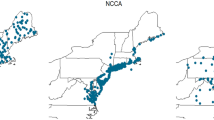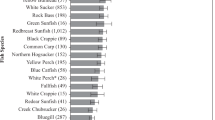Abstract
An unequal probability design was used to develop national estimates for 268 persistent, bioaccumulative, and toxic chemicals in fish tissue from lakes and reservoirs of the conterminous United States (excluding the Laurentian Great Lakes and Great Salt Lake). Predator (fillet) and bottom-dweller (whole body) composites were collected from 500 lakes selected randomly from the target population of 147,343 lakes in the lower 48 states. Each of these composite types comprised nationally representative samples whose results were extrapolated to the sampled population of an estimated 76,559 lakes for predators and 46,190 lakes for bottom dwellers. Mercury and PCBs were detected in all fish samples. Dioxins and furans were detected in 81% and 99% of predator and bottom-dweller samples, respectively. Cumulative frequency distributions showed that mercury concentrations exceeded the EPA 300 ppb mercury fish tissue criterion at nearly half of the lakes in the sampled population. Total PCB concentrations exceeded a 12 ppb human health risk-based consumption limit at nearly 17% of lakes, and dioxins and furans exceeded a 0.15 ppt (toxic equivalent or TEQ) risk-based threshold at nearly 8% of lakes in the sampled population. In contrast, 43 target chemicals were not detected in any samples. No detections were reported for nine organophosphate pesticides, one PCB congener, 16 polycyclic aromatic hydrocarbons, or 17 other semivolatile organic chemicals.
Similar content being viewed by others
References
Agency for Toxic Substances and Disease Registry (ATSDR). (1998). Toxicological profile for chlorinated dibenzo-p-dioxins (CDDs). Atlanta, GA: US Department of Health and Human Services, Public Health Service.
Agency for Toxic Substances and Disease Registry (ATSDR). (1999). Toxicological profile for mercury. Atlanta, GA: US Department of Health and Human Services, Public Health Service.
Agency for Toxic Substances and Disease Registry (ATSDR). (2000). Toxicological profile for polychlorinated biphenyls. Atlanta, GA: US Department of Health and Human Services, Public Health Service.
Bloom, N. (1992). On the chemical form of mercury in edible fish and marine invertebrate tissue. Canadian Journal of Fisheries and Aquatic Sciences, 49, 1010–1017.
Branson, D. R., Takahashi, I. T., Parker, W. M., & Blau, G. E. (1985). Bioconcentration kinetics of 2,3,7,8-tetrachlorodibenzo-p-dioxin in rainbow trout. Environmental Toxicology and Chemistry, 4, 779–788.
Bruggeman, W. A., Opperhuizen, A., Wijbenga, A., & Hutzinger, O. (1984). Bioaccumulation of super-lipophilic chemicals in fish. Toxicological and Environmental Chemistry, 7, 173–189.
Cope, W. G., Wiener, J. G., & Rada, R. G. (1990). Mercury accumulation in yellow perch in Wisconsin seepage lakes—relation to lake characteristics. Environmental Toxicology and Chemistry, 9, 931–940.
Fitzgerald, W. F., Engstrom, D. R., Mason, R. P., & Nater, E. A. (1998). The case for atmospheric mercury contamination in remote areas. Environmental Science and Technology, 32, 1–7.
Gardner, A. M., & White, K. D. (1990). Polychlorinated dibenzofurans in the edible portion of selected fish. Chemosphere, 21(1–2), 215–222.
Glassmeyer, S. T., Myers, T. R., DeVault, D. S., & Hites, R. A. (1997). Toxaphene in Great Lakes fish: A temporal, spatial, and trophic study. Environmental Science and Technology, 31, 84–88.
Isensee, A. R., & Jones, G. E. (1975). Distribution of TCDD in aquatic organisms. Environmental Science and Technology, 9, 668–672.
Jones, P. D., Kannan, K., Newsted, J. L., Tillitt, D. E., Williams, L. L., & Giesy, J. P. (2001). Accumulation of 2,3,7,8-tetrachlorodibenzo-p-dioxin by rainbow trout (Onchorhynchus mykiss) at environmentally relevant dietary concentrations. Environmental Toxicology and Chemistry, 20(2), 344–350.
Kucklick, J. R., Harvey, H. R., Ostrom, P. H., Ostrom, N. E., & Baker, J. E. (1996). Organochlorine dynamics in the pelagic food web of Lake Baikal. Environmental Toxicology and Chemistry, 15(8), 1388–1400.
Lange, T. R., Royals, H. E., & Connor, L. L. (1993). Influence of water chemistry on mercury concentration in largemouth bass from Florida lakes. Transactions of the American Fisheries Society, 122, 78–84.
Larsson, P., Okla, L., & Collvin, L. (1993). Reproductive status and lipid content as factors in PCB, DDT, and HCH contamination of a population of pike (Esox lucius L.). Environmental Toxicology and Chemistry, 12, 855–861.
Leaner, J. J., & Mason, R. P. (2004). Methylmercury uptake and distribution kinetics in sheepshead minnows, Cyprinodon variegatus, after exposure to Ch3Hg-spiked food. Environmental Toxicology and Chemistry, 23(9), 2138–2146.
Madenjan, C. P., Desorcie, T. J., Stedman, R. M., Brown, E. H., Jr., Eck, G. W., Schmidt, L. J., et al. (1999). Spatial patterns in PCB concentrations of Lake Michigan lake trout. Journal of Great Lakes Research, 25, 149–159.
McCarty, L. S., & Mackay, D. (1993). Enhancing ecotoxicological modeling and assessment. Environmental Science and Technology, 27, 1718–1728.
National Oceanic and Atmospheric Administration (NOAA) (1993). Sampling and analytical methods of the national status and trends program-national benthic surveillance and mussel watch projects 1984–1992. NOAA Technical Memorandum NOS ORCA 71. July, 1993.
Olsen, A. R., Stevens, D. L., Jr., & White, D. (1998). Application of global grids in environmental sampling. Computing Science and Statistics, 30, 279–284.
Olsen, A. R., Snyder, B. D., Stahl, L. L., & Pitt, J. L. (2008). Survey design for lakes and reservoirs in the United States to assess contaminants in fish tissue. Environmental Monitoring and Assessment doi:10.1007/s10661-008-0685-8.
Peterson, S. A., VanSickle, J., Herlihy, A. T., & Hughes, R. M. (2007). Mercury concentration in fish from streams and rivers throughout the western United States. Environmental Science and Technology, 41(1), 58–65.
R Development Core Team. (2007). The R project for statistical computing. R Development Core Team, Vienna, Austria (website). http://www.R-project.org.
Rose, J., Hutcheson, M. S., West, C. R., Pancorbo, O., Hulme, K., Cooperman, A., et al. (1999). Fish mercury distribution in Massachusetts, USA lakes. Environmental Toxicology and Chemistry, 18(7), 1370–1379.
Ruus, A., Ugland, K. I., & Skaare, J. U. (2002). Influence of trophic position on organochlorine concentrations and compositional patterns in a marine food web. Environmental Toxicology and Chemistry, 21(11), 2356–2364.
Sloan, R., Brown, M., Brandt, R., & Barnes, C. (1985). Hudson River PCB relationships between resident fish, water, and sediment. Northeastern Environmental Science, 3, 137–151.
Stafford, C. P., & Haines, T. A. (1997). Mercury concentration in Maine sport fish. Transactions of the American Fisheries Society, 126, 144–152.
Stevens, D. L., & Olsen, A. R. (2004). Spatially balanced sampling of natural resources. Journal of the American Statistical Association, 99, 262–278.
Stow, C. A., & Carpenter, S. R. (1994). PCB concentration trends in Lake Michigan coho (Oncorhynchus kisutch) and chinook salmon (O. tshawytscha). Canadian Journal of Fisheries and Aquatic Sciences, 51, 1384–1390.
US Environmental Protection Agency (USEPA) (1987). National dioxin study: Tiers 3, 5, 6, and 7. US EPA, Office of Water Regulations and Standards, Washington, DC. EPA-440/4-87-003.
US Environmental Protection Agency (USEPA) (1989). Method 1625C: Semivolatile organic compounds by isotope dilution GC/MS. US EPA, Office of Science and Technology, Engineering and Analysis Division. Washington, DC. Region 1#01A0006089.
US Environmental Protection Agency (USEPA) (1992). National study of chemical residues in fish. US EPA, Office of Science and Technology, Washington, DC. EPA 823-R-92-008a.
US Environmental Protection Agency (USEPA) (1994). Method 1613: Tetra- through octa- chlorinated dioxins and furans by isotope dilution HRGC/HRMS. Revision B. US EPA, Office of Water, Washington, DC. EPA 821-B-94-005.
US Environmental Protection Agency (USEPA) (1995). Guidance for assessing chemical contaminant data for use in fish advisories. volume 1: Fish sampling and analysis, 2nd ed. US EPA, Office of Water, Washington, DC. EPA 823-R-95-007.
US Environmental Protection Agency (USEPA) (1997). Guidance for assessing chemical contaminant data for use in fish advisories. volume 2: Risk assessment and fish consumption limits, 2nd ed. US EPA, Office of Water, Washington, DC. EPA 823-B-97-009.
US Environmental Protection Agency (USEPA) (1998). A multimedia strategy for priority persistent, bioaccumulative, and toxic (PBT) pollutants [DRAFT]. US EPA, Office of Pollution Prevention and Toxics, Washington, DC.
US Environmental Protection Agency (USEPA) (1999a). The national survey of mercury concentrations in fish—Database summary 1990–1995. US EPA, Office of Water, Washington, DC. EPA-823-R-99-014.
US Environmental Protection Agency (USEPA) (1999b). Update: National listing of fish and wildlife advisories. US EPA, Office of Water, Washington, DC. EPA-823-R-99-005.
US Environmental Protection Agency (USEPA) (1999c). Method 1631, Revision B: Mercury in water by oxidation, purge and trap, and cold vapor atomic fluorescence spectrometry. US EPA, Office of Water, Washington, DC. EPA 821-R-99-005.
US Environmental Protection Agency (USEPA) (1999d). Method 1668, Revision A: Chlorinated biphenyl congeners in water, soil, sediment, and tissue by HRGC/HRMS. US EPA, Office of Water, Washington, DC. EPA-821-R-00-002.
US Environmental Protection Agency (USEPA) (2000a). Field sampling plan for the national study of chemical residues in lake fish tissue. US EPA, Office of Water, Office of Science and Technology, Washington, DC. EPA-823-R-02-004.
US Environmental Protection Agency (USEPA) (2000b). Guidance for assessing chemical contaminant data for use in fish advisories, volume 1: Fish sampling and analysis, 3rd ed. US EPA, Office of Water, Washington, DC. EPA-823-B-00-007.
US Environmental Protection Agency (USEPA) (2000c). Method 1656, Revision A: Organo-halide pesticides in wastewater, soil, sludge, sediment, and tissue by GC/HSD. US EPA, Office of Water, Washington, DC. EPA-821-R-00-017.
US Environmental Protection Agency (USEPA) (2000d). Method 1657, Revision A: Organo-phosphorus pesticides in wastewater, soil, sludge, sediment, and tissue by GC/FPD. US EPA, Office of Water, Washington, DC. EPA-821-R-00-018.
US Environmental Protection Agency (USEPA) (2000e). Guidance for assessing chemical contaminant data for use in fish advisories, volume 2: Risk assessment and fish consumption limits, 3rd ed. US EPA, Office of Water, Office of Science and Technology, Washington, DC. EPA 823-B-00-008.
US Environmental Protection Agency (USEPA) (2001a). Appendix to Method 1631: Total mercury in tissue, sludge, sediment, and soil by acid digestion and BrCl oxidation. US EPA, Office of Water, Washington DC. EPA-821-R-01-013.
US Environmental Protection Agency (USEPA) (2001b). Method 1632, Revision A: Chemical speciation of arsenic in water and tissue by hydride generation quartz furnace atomic absorption spectrometry. US EPA, Office of Water, Washington, DC. EPA-821-R-01-006.
US Environmental Protection Agency (USEPA) (2001c). Water quality criterion for the protection of human health: methylmercury. US EPA, Office of Water, Office of Science and Technology, Washington, DC. EPA-823-R-01-001.
US Environmental Protection Agency (USEPA) (2005). Quality assurance report for the national study of chemical residues in lake fish tissue: Analytical data for years 1 through 4. US EPA, Office of Water, Washington, DC. EPA-823-R-05-005.
US Environmental Protection Agency (USEPA) (2006a). Wadeable stream assessment: A collaborative survey of the Nation’s streams. US EPA, Office of Water, Washington, DC. EPA 841-B-06-002.
US Environmental Protection Agency (USEPA) (2006b). Draft guidance for implementing the January 2001 methylmercury water quality criterion. US EPA, Office of Water, Washington, DC. EPA 823-B-04-001.
US Environmental Protection Agency (USEPA) (2006c). Persistent, bioaccumulative, and toxic (PBT) chemical program: Dioxins and furans. US EPA (website). http://www.epa.gov/pbt/pubs/dioxins.htm.
US Environmental Protection Agency (USEPA) (2007a). National Estuary Program coastal condition report. US EPA, Office of Water, Washington, DC. EPA-842-B-06-001.
US Environmental Protection Agency (USEPA) (2007b). National lake fish tissue study: results. US EPA (website). http://www.epa.gov/waterscience/fish/study/results.htm.
US Environmental Protection Agency (USEPA) (2007c). 2005/2006 National listing of fish advisories fact sheet. US EPA, Office of Water, Washington, DC. EPA-823-F-07-003.
Yeardley, R. B., Jr., Lazorchak, J. M., & Paulsen, S. G. (1998). Elemental fish tissue contamination in northeastern U.S. lakes: Evaluation of an approach to regional assessment. Environmental Toxicology and Chemistry, 17(9), 1875–1884.
Zar, J. H. (1999). Biostatistical analysis (4th ed.). Upper Saddle River, NJ: Prentice Hall.
Author information
Authors and Affiliations
Corresponding author
Rights and permissions
About this article
Cite this article
Stahl, L.L., Snyder, B.D., Olsen, A.R. et al. Contaminants in fish tissue from US lakes and reservoirs: a national probabilistic study. Environ Monit Assess 150, 3–19 (2009). https://doi.org/10.1007/s10661-008-0669-8
Received:
Accepted:
Published:
Issue Date:
DOI: https://doi.org/10.1007/s10661-008-0669-8




